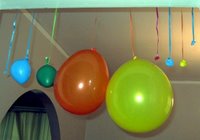 My neurologically typical--the diagnosis autistic people give people like me--son is in his freshman year of high school homeschool. For junior high and high school, we plan to keep Apologia as our spine for science. David is now working his way through biology and has fallen in love with our microscope.
My neurologically typical--the diagnosis autistic people give people like me--son is in his freshman year of high school homeschool. For junior high and high school, we plan to keep Apologia as our spine for science. David is now working his way through biology and has fallen in love with our microscope.The junior high material is too advanced for Pamela, my autistic aphasiac teen, who functions at an upper elementary grade level. We are trying Apologia's elementary science books. Pamela chose astronomy, one of four texts. She has just completed Lesson 1, and the book has engaged her imagination.
We have thoroughly explored the bonus material for readers of the book: Pamela made a montage of her favorite photos from the Hubble Telescope, a model of planet sizes using balloons (pictured below), and a model of distances in the solar system using 392 paper clips and ten marshmallows (pictured left). She printed photos depicting the relative size of the planets and more detailed biographies of Copernicus and Galileo. She loved the online solar system animations, which stimulated her vestibular system and ignited a gigglefest. She writes her narratons on notebook pages from a PDF file: Pamela illustrates and writes a narration of every reading. Her course notebook is already quite thick after only one lesson.
 We are Excel fanatics, and my husband and I both agree that no education is complete without a solid grounding in Excel. I made spreadsheets to estimate the distances between planets based upon the paper clip model and the planet sizes based upon the balloon model. When she entered the numbers, Pamela was fascinated to see the formulas calculated for her. I designed another spreadsheet in which Pamela can organize words roots. She looked up the root, language, meaning, and examples of words with the roots in a dictionary (i.e., astro-, Greek, star, astronomy, astronaut).
We are Excel fanatics, and my husband and I both agree that no education is complete without a solid grounding in Excel. I made spreadsheets to estimate the distances between planets based upon the paper clip model and the planet sizes based upon the balloon model. When she entered the numbers, Pamela was fascinated to see the formulas calculated for her. I designed another spreadsheet in which Pamela can organize words roots. She looked up the root, language, meaning, and examples of words with the roots in a dictionary (i.e., astro-, Greek, star, astronomy, astronaut).

No comments:
Post a Comment